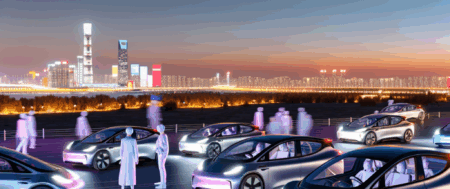China, the world’s largest automotive market, presents a unique mix of challenges and opportunities, fueled by a growing economy and rapid urbanization. The shift towards Electric Vehicles (EVs) and New Energy Vehicles (NEVs), supported by government incentives, aims to address environmental concerns and position China as a leader in green technology. Success in this competitive market requires navigating a complex regulatory landscape, with joint ventures between foreign automakers and domestic car brands being essential for market entry. These partnerships, along with an understanding of consumer preferences and technological advancements, are crucial for adapting to intense market competition. Despite the hurdles, China’s emphasis on EVs, NEVs, and its vast consumer base offers significant growth and innovation opportunities for companies willing to explore strategic partnerships and adapt to the evolving automotive sector.
In the heart of the global automotive sector, China stands as a colossus, its streets and highways thrumming with the latest in both domestic car brands and foreign models. As the world’s largest automotive market, China’s influence stretches far beyond its borders, shaping industry trends, dictating market dynamics, and setting the pace for innovation. With its rapidly growing economy, burgeoning middle class, and the relentless march of urbanization, the country has become the epicenter of automotive evolution, particularly in the realms of Electric Vehicles (EVs) and New Energy Vehicles (NEVs). These segments, buoyed by substantial government incentives and a collective environmental consciousness, are driving the future of mobility on a global scale.
However, navigating China’s automotive landscape is no small feat for automakers. The terrain is marked by a complex regulatory landscape that demands not only an understanding of local consumer preferences but also strategic partnerships through joint ventures with local entities. These alliances are crucial for foreign automakers to unlock the door to this vast consumer base. Moreover, the market’s competitiveness is further intensified by technological advancements, environmental concerns, and constantly shifting government policies.
This article delves deep into the dynamics of “Navigating the World’s Largest Automotive Market: Trends, Opportunities, and Challenges in China’s Dynamic Landscape.” It offers an incisive look at how both international and domestic players are positioning themselves within this highly competitive environment. From exploring the surge in EV and NEV popularity, to dissecting the intricacies of forming successful joint ventures and understanding the pivotal role of consumer preferences and technological innovations, this narrative unpacks the layers that make China’s automotive market both immensely rewarding and complex. Join us as we explore the strategic maneuvers and insights required to thrive in the ever-evolving, ever-expanding automotive frontier of China.
1. “Navigating the World’s Largest Automotive Market: Trends, Opportunities, and Challenges in China’s Dynamic Landscape”

Navigating the complex and dynamic terrain of the world’s largest automotive market, China, presents a unique blend of challenges and opportunities for both domestic and foreign automakers. At the heart of this bustling market are the twin engines of a rapidly growing economy and an accelerating pace of urbanization, driving an insatiable demand for mobility solutions among a burgeoning middle class. This demand spans a broad spectrum of automotive offerings, from traditional internal combustion engine vehicles to Electric Vehicles (EVs) and New Energy Vehicles (NEVs), the latter categories buoyed by significant government incentives aimed at addressing environmental concerns and establishing China as a global leader in green technology.
The shift towards EVs and NEVs underscores a wider trend of technological advancements within the automotive sector, where consumer preferences increasingly lean towards innovative, eco-friendly, and smart mobility solutions. This evolving consumer base, coupled with the Chinese government’s push for cleaner energy sources, has made the market especially attractive for players in the EV and NEV segments. However, the allure of the largest automotive market comes with its share of hurdles. The regulatory landscape in China is notably complex, necessitating strategic partnerships in the form of joint ventures between foreign automakers and established domestic car brands to effectively navigate the intricacies of market entry and expansion.
These joint ventures serve multiple purposes; they offer foreign automakers a vital foothold in the market and valuable insights into consumer preferences, while also facilitating compliance with local regulations. For domestic brands, these collaborations bring in advanced technological know-how and international prestige, enhancing their competitive edge both locally and globally. Yet, the market competition in China is fierce, with a plethora of brands vying for consumer attention. This intense competition forces companies to continuously innovate and adapt to the rapidly changing tastes of Chinese consumers, who are becoming increasingly sophisticated and discerning in their vehicle choices.
The strategic partnerships that foreign and domestic players form are crucial not just for survival but for thriving in this competitive landscape. These alliances enable companies to leverage each other’s strengths, be it in manufacturing, technology, distribution, or understanding of the local market, to create offerings that resonate with consumers and adhere to governmental guidelines.
In conclusion, the Chinese automotive market, with its vast consumer base, growing economy, and emphasis on EVs and NEVs, presents a land of immense potential for automakers worldwide. However, success in this market is not guaranteed. It requires a deep understanding of the regulatory landscape, consumer preferences, and the importance of strategic partnerships. For companies willing to navigate its complexities, China offers unparalleled opportunities for growth and innovation in the automotive sector.
In conclusion, the journey through China’s dynamic automotive landscape reveals a market of unparalleled scale and complexity. As the largest automotive market in the world, China presents both vast opportunities and significant challenges for domestic and foreign automakers alike. The country’s growing economy, expanding urbanization, and the rise of a burgeoning middle class have fueled a high demand for vehicles, placing a particular emphasis on Electric Vehicles (EVs) and New Energy Vehicles (NEVs). This shift towards cleaner modes of transportation is driven by not only environmental concerns but also by attractive government incentives, underlining the importance of aligning with regulatory expectations and consumer preferences.
The competitive edge in this market often hinges on the ability to form strategic partnerships through joint ventures, a necessary maneuver to navigate the complex regulatory landscape while tapping into the vast consumer base. The success of both domestic car brands and foreign automakers in China depends on their adaptability to market competition, technological advancements, and the ever-evolving preferences of Chinese consumers.
Understanding and leveraging these elements are crucial for any player aiming to succeed in China’s automotive sector. The interplay of government policies, environmental concerns, and the push for innovation sets a unique stage for the industry’s future. As the market continues to evolve, those who can anticipate changes and strategically position themselves will be best equipped to thrive in the world’s top automotive market. The road ahead is both challenging and exciting for stakeholders in China’s automotive industry, demanding a deep commitment to understanding the market’s nuances and seizing the opportunities that lie within its complex yet rewarding environment.






